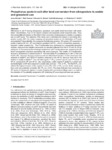Please use this identifier to cite or link to this item:
http://www.alice.cnptia.embrapa.br/alice/handle/doc/1004999Full metadata record
| DC Field | Value | Language |
|---|---|---|
| dc.contributor.author | SLAZAK, A. | pt_BR |
| dc.contributor.author | FREESE, D. | pt_BR |
| dc.contributor.author | MATOS, E. da S. | pt_BR |
| dc.contributor.author | NII-ANNANG, N. | pt_BR |
| dc.contributor.author | HÜTTL, R. F. | pt_BR |
| dc.date.accessioned | 2015-01-09T11:11:11Z | pt_BR |
| dc.date.available | 2015-01-09T11:11:11Z | pt_BR |
| dc.date.created | 2015-01-09 | pt_BR |
| dc.date.issued | 2014 | pt_BR |
| dc.identifier.citation | Journal of Plant Nutrition and Soil Science, v. 1777, n. 2, p. 159-167, 2014 | pt_BR |
| dc.identifier.issn | 1436-8730 | pt_BR |
| dc.identifier.uri | http://www.alice.cnptia.embrapa.br/alice/handle/doc/1004999 | pt_BR |
| dc.description | Differences in soil P among silvopasture, grassland, and arable lands have been well established. Nevertheless, most of the reports compare soil properties under long-term sites. Thus, there exists little information on the effect of the conversion of silvopasture to arable or grassland use on soil P pools. The objective of the study was to determine the impact of converting silvopasture system (SP) into arable cropping and grassland system on the distribution of P pools and potential P bioavailability. We compared the following systems: SP system, SP converted to arable cropland (SP-AL), SP converted to grassland (SP-GL), and for comparative purposes, a long-term arable cropland (AL). The P fractionation was performed by a sequential extraction scheme, using acid and alkaline extractants on samples collected from the 0?10 and 10?20 cm soil layers. It was assumed that the large variations in soil-P fractionations are caused by the different management practices associated with land conversion. The results of P fractionation showed a dominance of calcium-bound P, HCl-extractable Pi constituted up to 36% of the soil total P (TP). However, the type of land use did not affect this P fraction. On the other hand, the reduction in labile-Pi and NaOH-Pi fractions observed at the SP-AL site may have led to the decline in readily available P. The soil total organic P (TPo) content was 8% and 17% lower at SP-AL compared to SP and SP-GL site, respectively. Labile organic-P (labile-Po) content was markedly higher at SP site compared to arable soils, and was ≈ 10% of TPo. The NaOH-Po constituted the highest fraction of the organic-P pool (55%?79% of TPo) across all the study systems, and was positively correlated with TPo (p < 0.01). The study indicates that conversion of SP system in temperate regions to arable cropping with conventional tillage seems to result in the reduction of P availability compared to SP, indicating SP as an important land-use practice. | pt_BR |
| dc.language.iso | por | pt_BR |
| dc.rights | openAccess | pt_BR |
| dc.subject | Sistema Silvipastoril | pt_BR |
| dc.title | Phosphorus pools in soil after land conversion from silvopasture to arable and grassland use. | pt_BR |
| dc.type | Artigo de periódico | pt_BR |
| dc.date.updated | 2015-01-09T11:11:11Z | pt_BR |
| dc.subject.thesagro | Uso da Terra | pt_BR |
| dc.subject.nalthesaurus | Agricultural soils | pt_BR |
| dc.subject.nalthesaurus | Silvopastoral systems | pt_BR |
| dc.subject.nalthesaurus | Zoning | pt_BR |
| riaa.ainfo.id | 1004999 | pt_BR |
| riaa.ainfo.lastupdate | 2015-01-09 | pt_BR |
| dc.identifier.doi | dx.doi.org/10.1002/jpln.201200334 | pt_BR |
| dc.contributor.institution | Anna Slazak, Chair of Soil Protection and Recultivation, Brandenburg University of Technology, Cottbus, Germany; Dirk Freese, Chair of Soil Protection and Recultivation, Brandenburg University of Technology, Cottbus, Germany; EDUARDO DA SILVA MATOS, CPAMT; Seth Nii-Annang, Chair of Soil Protection and Recultivation, Brandenburg University of Technology, Cottbus, Germany; Reinhard F. Hüttl, Helmholtz-Centre Potsdam - GFZ, German Research Centre for Geosciences, Telegrafenberg, Germany. | pt_BR |
| Appears in Collections: | Artigo em periódico indexado (CPAMT)  | |
Files in This Item:
| File | Description | Size | Format | |
|---|---|---|---|---|
| cpamt2014matosphosphorussilvopasture.pdf | 203.88 kB | Adobe PDF |  View/Open |









